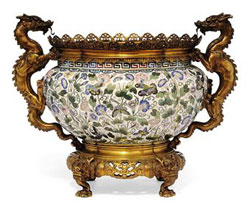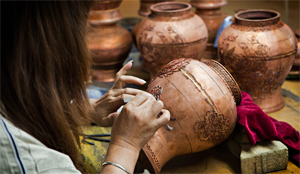Chinese Cloisonne
Cloisonné is one of the well-known traditional enamelware arts and crafts in Beijing, and its history dates back to over 700 years ago. It is actually called the "Blue of Jingtai" as under the reign of Jingtai (1450–1456) in the Ming Dynasty, the emperor was very fond of bronze-casting techniques, and improved the color process, creating the bright blue “Jingtailan” cloisonné products, which then became popular among the people.
Origin & Improvements
Cloisonné originated in Beijing during the Yuan Dynasty (1271–1368).
 It became prevalent during the reign of Jingtai (1450–1456) in the Ming Dynasty as the emperor was very fond of bronze-casting techniques and created bright blue as the dominant color of enameling. Cloisonne was mostly used on large vessels at that time such as tripods, incense burners, washbasins, charcoal-basins, jars and vases.
It became prevalent during the reign of Jingtai (1450–1456) in the Ming Dynasty as the emperor was very fond of bronze-casting techniques and created bright blue as the dominant color of enameling. Cloisonne was mostly used on large vessels at that time such as tripods, incense burners, washbasins, charcoal-basins, jars and vases.
Cloisonné improved in gold-plating technique and developed more images during the Qing Dynasty (1644–1911), especially under the region of the emperor of Qianlong (1736–1796). Cloisonné can be found in various shapes and sizes from tables, folding chairs, and screens to chopsticks, snuff bottles, and bowls. The Cloisonné of the Republic of China is far behind that of the Ming and Qing dynasties in model, color and technique. Most of the products at that time are porcelain reproductions of Qing Dynasty Cloisonné.
With the improvement of traditional craftsmanship and modern techniques, Cloisonné is commonly used in many large objects and small items like earrings, bangles, bracelets, figurines and other adornments. It has been highly praised for its brilliant workmanship.
Technical Process
 Cloisonné is a sophisticated decorative enamel work which involves six complicated processes: base-hammering, filigree soldering, enamel-filling, enamel firing, polishing, and gilding.
Cloisonné is a sophisticated decorative enamel work which involves six complicated processes: base-hammering, filigree soldering, enamel-filling, enamel firing, polishing, and gilding.
Copper is molded into the required shape, after being hammered and stretched, and then copper strips are adhered to the copper body, which requires great care and high creativity. Then comes enamel filling. Ores are ground into fine powder and contained on plates.
Craftsmen then apply them to the little compartments separated by filigrees, and put the article into the crucible for firing. Re-filling is repeatedly required, as the enamel will sink down a little after firing. After repeated polishing and firing, and the last step of placing it in gold or silver, a finished cloisonné product is produced.
Where can I buy cloisonné in Beijing?
 As Chinese craftsmen constantly improve and enhance techniques, you can find cloisonné products in various shapes and sizes everywhere in Beijing, from the smallest tourist shops to the largest shopping malls. Price varies according to the object and the year it was made.
As Chinese craftsmen constantly improve and enhance techniques, you can find cloisonné products in various shapes and sizes everywhere in Beijing, from the smallest tourist shops to the largest shopping malls. Price varies according to the object and the year it was made.
We recommend you go to Huairou Cloisonne Factory, situated close to the Mutianyu Great Wall to make sure you do not buy fake items. Huairou Cloisonne Factory is the largest Cloisonne factory in Beijing, and the products are of high quality and reasonable price. At the factory, where cloisonné products are made, you can also watch the craftsmen work, to see how the cloisonné pieces are produced. We include a visit to the Cloisonne factory in our pre-arranged Beijing tours.

